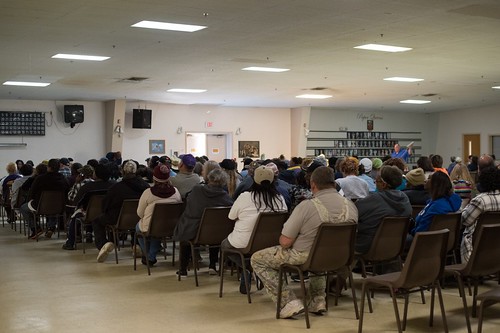
Incidents described as “thousand year storms and floods” and “the worst U.S. disaster since Hurricane Sandy” claimed the lives of more than 58 people in Louisiana, West Virginia and South Carolina over the last year. These disasters often remind us of the devastating impacts that families and their communities face after they strike.
After emergency life saving operations, food and shelter assistance are the most important priorities with which emergency managers must contend. It was during these times that the U.S. Department of Agriculture’s Food and Nutrition Service (FNS) responded to 22 incidents by providing needed nutrition assistance. More than half of these disasters involved severe and widespread flooding, including the most recent floods that affected residents in 22 parishes in and around Baton Rouge, Louisiana.
So far, USDA has issued over $60.2 million in Disaster Supplemental Nutrition Assistance Program (D-SNAP) benefits to more than 286,000 survivors of the August flooding in Louisiana and over $19.6 million in replacement benefits to 254,000 SNAP recipients who lost food because of the flooding.

During any disaster, FNS works with its disaster feeding partners so that survivors will have access to food. I had the chance to meet some of these survivors and hear their stories, not only of what it was like to live through the floods, but also how they were able to recover from the devastation as well as provide food for their families using USDA’s disaster nutrition assistance programs.
Gbenga Bello lived in Baton Rouge for 30 years and never had been affected by a disaster, until the flooding in Louisiana last month. As the D-SNAP Site Supervisor in West Feliciana Parish, Gbenga has been assisting those in need for many years, and now he finds himself to be one of those in need of food assistance. “It was a humbling experience…but life goes on; we will get through this and keep moving forward.”

Glenn LaBlanc, a D-SNAP recipient in St. Gabriel Parish, La. who was evacuated from her flooded trailer home, said that it has been a “wonderful blessing to get assistance from the good people in the government, helping those in need, coming together in a desperate time such as now.”
In October 2015, during the South Carolina flooding that would go down as one of the most prolific rainfall events in modern history, Katherine Walsh sat in her living room with her twin, three-year old sons. As water rushed through their front door, she grabbed her kids “…and prayed that the water didn’t come any higher.” After five days of constant storms, some areas received nearly 27 inches of rainfall, a record high for the state. Nineteen died, hundreds were forced from their homes, while many others lost their cars or were unable to work.
D-SNAP is one of the primary nutrition assistance programs that USDA FNS can provide to those most severely impacted by disasters and who are in need of short-term food assistance.
Spencer Kennedy recounted being at home in his trailer in Charleston, SC, with his children who thought the rising water was “fun” at first. They quickly changed their minds once the walls of their trailer home began to buckle and their home started sinking into the oversaturated ground. Then, reports of alligators in the water began to spread.
As a Disaster Response Coordinator for FNS, I’m proud to be a part of an agency that can provide food assistance to disaster survivors, even if it’s only a small part of the response efforts. USDA works with federal, state, local and voluntary agency partners, such as FEMA, the American Red Cross and the Salvation Army, who are the “boots on the ground.” Through them, USDA Foods are distributed to disaster survivors at mass feeding shelters, or, in some cases, for household distribution. Through these partnerships, USDA ensures that families receive the food they need, as many retail grocery stores could be closed soon after a large disaster.
Once stores re-open and an impacted area has received a Presidential Disaster Declaration for Individual Assistance, a state agency might decide to request to operate a D-SNAP if food assistance is still needed. USDA FNS works closely with the state to approve a D-SNAP to start serving survivors who are most in need. Katherine and Spencer were survivors who don’t qualify for regular SNAP benefits, but they needed short-term emergency help to feed their families because of disaster-related expenses.
At the D-SNAP site in Charleston, SC, lines of people wrapped around the Convention Center waiting to apply for benefits. While it had been a full month since the excessive rainfall, families still sought assistance and hoped to find a little relief. A young mother approached me with tears in her eyes saying, “thank you a million times over for being here for the people of South Carolina.” Gratitude radiated through her and other survivors who received benefits that day.
I feel privileged and proud to work for an agency that can support a community get back on its feet, and help alleviate the stress that follows a disaster. Thanks to the readiness of our federal, state, tribal, faith-based and non-governmental partners, we are able to uplift communities and help them emerge stronger when disasters strike.
Because September is National Preparedness Month and after working with our partners on these disasters, it is a good time to think about emergency planning. Don’t Wait. Communicate. Make an Emergency Communication Plan for you and your family because you just don’t know when disasters will impact your community.
If you are in need of food for your family following a disaster, contact the disaster relief organization in your area to determine where you can find food assistance. For more information on FNS’ disaster nutrition assistance programs, visit www.fns.usda.gov/disasters.




